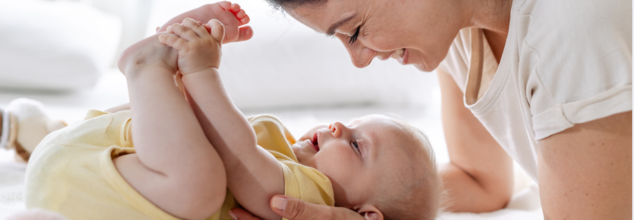- Health Conditions A-Z
- Health & Wellness
- Nutrition
- Fitness
- Health News
- Ayurveda
- Videos
- Medicine A-Z
- Parenting
- Web Stories
Baby’s First Year: Month-By-Month Guide To Infant Developmental Milestones

Baby’s First Year: A Guide To Infant Developmental Milestones
The first year is the most phenomenally transformational period of a baby's life. Your little one evolves from an absolutely helpless newborn into a lively toddler within 12 short months, with significant milestones achieved during this process. From the first coo to the first step, this period is all joy and curiosity for new parents. While developmental milestones give a guide to this development, it's important to note that every baby is unique and that the timelines for these milestones vary.
The first year of any baby's life is a rollercoaster of emotions, growing, and learning. While guides are helpful, every baby is unique, and things develop on their timeline. Celebrate each small thing, knowing that these will be the building blocks that form your child's life.
Developmental Milestones
Developmental milestones are the key behaviors and physical skills children achieve as they grow. These milestones fall into four categories: physical, cognitive, social/emotional, and language/communication.
- Physical milestones: Rolling over, sitting, crawling, standing, and eventually walking.
- Cognitive milestones: Tracks objects, solves simple problems, explores environment.
- Social/emotional milestones: Smiles, laughs, exhibits stranger or separation anxiety.
- Language milestones: Babbling, cooing, and saying first words.
Each baby grows in a special way, so the timeline of development has small differences from one to another. Knowledge of what a baby does each month allows parents to support their little one with confident and caring gestures.
Month 1: The Newborn Phase
At birth, babies are mainly concerned with adapting to life outside the womb. During the first month, your baby's development is around basic reflexes and sensory experiences:
Reflexes: Flinching at loud noises and shutting their eyes at bright lights.
Sensory Development: Focusing on objects within 12 inches and turning toward familiar sounds, especially their parents' voices.
Hand Movements: Bring hands and fists toward their mouth but not in much control. Though these actions seem rudimentary, they are foundations for more advanced skills.
Month 2: The First Social Smiles
By two months of age, babies start exhibiting more social interaction. Parents like to see the first smile from their baby, signifying increasing interaction:
Social Skills: Smiling and cooing, responding to familiar faces and voices.
Motor Development: Trying to hold his or her head up, and pushing up with his or her arms when in tummy time.
Visual Tracking: Moving the eyes to follow movement, coordination still developing.
All these small steps mean transition from newborn reflexes into intentional actions.
3-4 months: Strengthening and Interacting
By the third and fourth months, your baby becomes more sensitive to their environment, engaging with objects and people:
Head Control: The child is able to hold its head steady and upright for more extended periods.
Grasping: The baby is able to hold onto toys, such as rattles, and shake them.
Expression: The baby mimics parental expressions and coos more often.
Rolling Over: Some babies will begin rolling from tummy to back.
This is also when babies begin to recognize emotions in voices, deepening their bond with caregivers.
Months 5-6: Exploring the World
By mid-year, your baby’s strength and coordination improve significantly. You’ll notice more deliberate movements and an eagerness to explore:
Sitting Up: Briefly sitting without support and pushing themselves up during tummy time.
Object Play: Transfer of objects from one hand to another and oral exploration. Language Development: Babbling with consonant and vowel sounds like "ma-ma" or "da-da."
Emotional Expression: Laughing, squealing, or whining based on feelings.
At this age, solid foods can also be introduced since babies indicate readiness through interest in meals and greater control over their hands.
Months 7-8: On the Move
The last half of the year increases mobility and curiosity. For months seven and eight, babies will begin to develop some more complex motor skills such as:
Sitting Independently: Sit for long periods without support.
Crawling Pre-Cursors: Rocking on hands and knees, ready to crawl.
Standing: Pull up to a standing position by holding onto furniture.
Hand Skills: Using the "raking grasp" to reach for objects and moving them from one hand to another.
Emotionally, babies begin to recognize tones of voice and exhibit stranger anxiety, a normal phase in their socialization.
Months 9-10: Crawling and Cruising
By nine months, your baby is likely to be on the move, learning the thrill of getting around on his or her own:
Crawling: Most babies start crawling, but some skip this stage and cruise right to walking.
Pincer Grip: Picking up small objects with their thumb and forefinger.
Cruising: Walking while holding onto furniture, a precursor to walking.
Language Skills: Babbling strings of consonants, with occasional "words" like "mama."
Expect much exploration and experimentation, as babies like to explore objects by banging, throwing, or dropping them.
Months 11-12: The First Steps
As the first year comes to a close, your baby becomes an emerging toddler. During months 11 and 12, they often take their first independent steps:
Walking: Some babies start walking on their own, while others cruise.
Communication: Using simple words such as "hi" or "bye" and understanding simple commands.
Imitation: Imitation is shown through actions such as pretending to talk on the phone.
Problem-solving: Placing objects in and out of containers is one of the signs of cognitive development.
By the end of the first year, the baby's growth shows an incredible mixture of physical, emotional, and social milestones.
Ways You Can Support Your Baby's Development
Parents play a critical role in fostering growth. Provide a safe and stimulating environment with toys and activities that encourage exploration. Regular check-ups with a pediatrician ensure milestones are met, and any concerns are addressed promptly.
When Should You Consult a Paediatrician?
If you feel that your baby is not advancing in milestones or is delayed significantly, trust that instinct and visit a doctor. Early intervention can mean all the difference, and as a parent, you are always right.
Is It Safe To Let Teens Drive? Study Finds Teens Spend A Fifth Of Their Time Driving, On The Phone

(Credit-Canva)
Learning how to drive is a big step of independence for children. It marks a phase where they learn responsibility, how to manage the autonomy they have gained as well as their way around different situations. There are many dangers associated with driving, hence there is a level of trust a parent must have before they let their teens drive. Whether it is others driving recklessly, difficult roads to travel in or themselves being careless. As teens are very well known for their lack of well-thought out actions, many of them find using their phones while driving normal.
A new study reveals a concerning trend: about one-fifth of the time, teenage drivers are looking at their smartphones instead of the road. This means they're not paying attention to what's in front of them or checking their mirrors.
The study, published in the journal Traffic Injury Prevention, found that teen drivers spend an average of 21% of each trip focused on their phone. What's more, these weren't just quick peeks. Nearly 27% of the time, drivers were looking at their phones for two seconds or longer. This amount of time dramatically increases the chance of a car crash.
Why Teens Use Their Phones Behind the Wheel
So, what are teens doing on their phones while driving? The study showed:
- Entertainment (like social media or videos) was the top reason, accounting for 65% of phone use.
- Texting came in second at 40%.
- About 30% of teens used their phone's GPS for navigation.
The Dangers of Distracted Driving
Distracted driving is a serious threat to public safety, especially among young drivers. When someone drives while distracted, they're not just putting themselves at risk of injury or death; they're endangering everyone else on the road.
While 35 U.S. states have laws banning all phone use for young drivers, a previous national study found that nearly 92% of teens still regularly use their smartphones for texting, talking, or playing music while driving.
What Teens Understand (and What They Don't)
For this new study, researchers asked over 1,100 teenagers about their habits and beliefs regarding smartphone use while driving.
Many young drivers actually understand that bad things can happen when they're distracted. They also know that their parents and friends wouldn't want them using their phones while driving. Teens also strongly believe they can avoid distracted driving by using features like "Do Not Disturb," hands-free modes, or phone holders. They recognize the benefits of using phone features like GPS but also understand the higher risk of accidents when distracted.
However, teens also said that their friends often drive while distracted by their phones. This suggests that more teens might be giving in to the temptation than they're willing to admit.
How to Encourage Safer Driving
Researchers suggest creating messages that challenge false beliefs about using phones while driving, such as the idea that you can still be productive on your phone while in transit. To help reduce this dangerous behavior, they recommend:
- Encouraging the use of "Do Not Disturb" mode on phones.
- Keeping phones out of reach while driving.
- Making sure teens get enough sleep, as tiredness can also increase distraction.
3 Medical Emergencies Schools Should Be Prepared For - Biggest Concerns For Paramedic Responses

(Credit-Canva)
Accidents can happen anytime and anywhere. Even if it is at school or at any other trust place. Health crisis may not seem like a big concern for school going children, however, understanding how unpredictable injuries and health concerns can be, it is important that emergency services are always ready. Many times, during these situations, a quick response is crucial, losing even moments could make or break the crisis.
However, what are the most likely health situations that can arise and how much should a school be worried about? New research reveals that U.S. schools should prioritize preparedness for three common health emergencies: brain-related crises, psychiatric/substance abuse issues, and trauma-related injuries. These three categories collectively account for approximately half of all emergency medical services (EMS) responses to schools.
Key Findings from the Study
A report published in the journal Pediatrics analyzed over 506,500 EMS calls to schools between 2018 and 2022, focusing on children aged 5 to 17. The study identified the following breakdown of emergency types:
- Neurologic problems (e.g., seizures): 19% of EMS calls.
- Psychiatric conditions or substance abuse: Nearly 17% of calls.
- Accidental injuries: Another 15% of calls.
The study also noted differences across age groups: elementary school students were more likely to require treatment for physical injuries (17%), while teenagers more frequently needed help for psychiatric conditions or substance abuse (18%).
Enhancing School Preparedness
Researchers emphasized the need for schools to enhance their emergency preparedness. He highlighted that timely treatment is crucial and suggested specific areas for staff training. According to US School Safety guidelines planning for emergencies must involve actions and daily routines that help create a secure school environment. These efforts can stop bad things from happening or lessen their impact if they do. Good planning also helps schools find and fix any weaknesses in their procedures and helps school staff and local emergency teams understand and handle their duties.
Creating a School Emergency Plan
A key part of emergency planning is putting together a complete school emergency operations plan (EOP). This is a document that explains what students, teachers, and school staff should do before, during, and after an emergency.
Developing this plan should be a team effort. It needs a diverse group of people from the school, as well as local community partners. Schools should also plan to check, evaluate, and update their EOP regularly to keep it current and effective.
Doing training, exercises, and drills that are right for different age groups can also help schools get ready for emergencies. These activities help everyone in the school community know their roles before, during, and after an emergency. They also give people a chance to practice the steps outlined in the EOP and improve how prepared they are.
Exercises and drills should be customized to fit the specific school community, including students' ages and physical abilities. It's also important to balance these drills with the school's overall culture and atmosphere.
Planning for Recovery After an Incident
Schools and districts can also plan for how they'll recover from emergencies even before they happen. This can make the recovery process quicker and more effective. As part of this, school emergency management teams should have a general strategy and plan to help the school community recover academically, physically, emotionally, and financially after an emergency.
C-Section Births May Raise Odds Of Leukemia In Children, Study Finds

Credits: Canva
A new Swedish study has found that children born via planned Cesarean section (C-section) may face a modestly increased risk of developing acute lymphoblastic leukemia (ALL), the most common type of cancer in children. This revelation adds to growing concerns around the long-term health impacts of elective C-sections—especially those not medically necessary.
Researchers from Sweden's Karolinska Institutet analyzed the health records of nearly 2.5 million children born between 1982 and 1989 and again from 1999 to 2015. Among this massive cohort, about 376,000 children were born via C-section. Of those, nearly 1,500 were diagnosed with leukemia later in life.
The findings, published recently, show that the risk of developing ALL was 21% higher among children born via planned C-section compared to those born vaginally. Even more specifically, the risk of B-cell ALL—a subtype of the disease—was 29% higher in the planned C-section group.
It’s worth noting that this elevated risk was not observed in children born through emergency C-sections, suggesting that the timing and conditions of birth may play a significant role.
While the researchers were cautious about drawing definitive conclusions, they outlined several potential explanations. One key theory revolves around the lack of exposure to natural vaginal microbiota and birth canal stress during planned C-sections. Both of these factors are believed to play a role in shaping an infant’s immune system.
"C-sections are an important and often life-saving part of obstetric care. We don't want mothers to feel anxious about medically indicated C-sections," said study author Christina-Evmorfia Kampitsi. "But there is reason to discuss non-medically necessary planned C-sections, especially in light of other findings linking them to increased risks of asthma, allergies, and type 1 diabetes."
Despite these findings, experts emphasize that the overall risk remains small. According to the researchers, the increased risk translates to approximately one additional case of B-cell ALL per year in Sweden. Still, in the realm of pediatric health, even a marginal uptick is worth examining—especially when linked to elective medical decisions.
Also Read: Screen Time Could Be Slowing Your Kids Down, Here's What The Study Says
Globally, C-section rates have been rising, particularly in high-income countries like the United States, where about 1 in 3 births now occur via C-section. Many of these are elective or scheduled for convenience rather than medical necessity.
What is Acute Lymphoblastic Leukemia?
ALL is a fast-growing form of blood and bone marrow cancer that primarily affects white blood cells. According to the Mayo Clinic, while its exact causes remain unclear, genetic predispositions and immune system factors may play a role. The disease is most common in children, especially between the ages of 2 and 5.
Symptoms include fatigue, frequent infections, fever, bone pain, and easy bruising or bleeding. Fortunately, thanks to advances in treatment, survival rates for childhood ALL have significantly improved in recent decades, with many children achieving full remission.
Role of Microbiota and Immune Development
One of the more compelling areas of study focuses on the role of gut microbiota in immune system development. Babies born vaginally are exposed to beneficial bacteria from their mother's birth canal, which begin colonizing the infant's gut immediately.
Planned C-section deliveries bypass this process. Some experts theorize that this may lead to delayed immune development, leaving children more vulnerable to certain autoimmune diseases and, potentially, cancers like leukemia.
Stress exposure during birth may also be key. Emergency C-sections—often occurring after labor has begun—still subject infants to the hormonal and physiological stresses of labor, which might help "prime" the immune system in ways that scheduled C-sections do not.
Interestingly, the study noted that the increased risk of leukemia was more pronounced in boys than in girls. The reasons for this are not yet clear and warrant further investigation, but they hint at possible genetic or hormonal differences in how children respond to birth conditions.
What This Means for Parents?
It’s essential to emphasize that the vast majority of children born via planned C-section will not develop leukemia. The study does not advocate against C-sections when medically necessary; instead, it calls for more thoughtful consideration around elective procedures.
Healthcare providers and parents should have open conversations about the risks and benefits associated with different birth methods. As always, individual medical needs should guide delivery decisions.
Dr. Christina-Evmorfia Kampitsi put it succinctly: “Fortunately, acute lymphoblastic leukemia is rare. But as our understanding of early-life exposures grows, so should our caution when it comes to non-essential medical interventions.”
Meanwhile, Dr. Mark Nordberg, a pediatric oncologist not involved in the study, says the research adds "an important piece to the puzzle" of understanding cancer risks in children. "This doesn’t mean we should panic about C-sections, but we should continue to refine how and when we use them."
Future research is expected to further explore the links between birth methods and immune-related diseases, including cancer. Larger studies across diverse populations and long-term health tracking may help isolate the variables at play.
Until then, parents and physicians should remain informed and cautious, using research like this as a tool to guide smarter, safer childbirth decisions for generations to come.
© 2024 Bennett, Coleman & Company Limited

